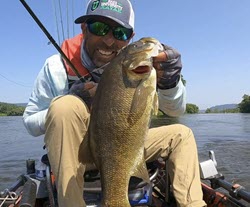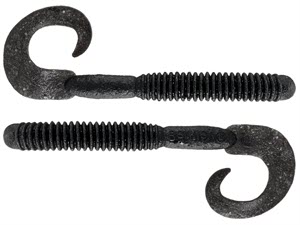
Let’s dive into a technique that’s a total game-changer when it comes to catching big bass, lots of bass, and sometimes, it’s the only way to get those stubborn fish to bite. We’re talking about speed worms, swim worms, cut tails, paddle tails, whatever you want to call them, I like to call them speed worms or swim worms. I’m going to show you why this little worm can make all the difference when other lures just aren’t working.
Before we jump into the nitty-gritty of these worms, let me take you back to 2003. I was fishing the Bassmaster Classic on the Louisiana Delta, and I found myself in an area down in Venice called Delta Duck. It’s a giant weed flat that was tough to fish with traditional lures like spinnerbaits or buzz baits. It was in this challenging environment that the speed worm became my secret weapon. That little worm helped me win the Classic. It holds a special place in my heart, and to this day, it’s my go-to in certain situations where nothing else seems to work.
So, what exactly is a speed worm or swim worm? In its simplest form, a swim worm or speed worm is a plastic worm, but it’s got something special going on with its tail. The upper body of these baits looks just like a regular plastic worm but it’s thicker at the top and tapers down toward the tail. The tail is where the magic happens! These baits have a paddle tail, a cut tail, or some sort of tab tail on the bottom. This unique tail is what sets them apart from other worms. That little paddle or tab creates a vibration in the water that drives bass wild. The movement of that tail is the key to triggering those bites when other lures fail.

There are a couple different types of speed worms so I’m going to explain how you can modify them to make them even more effective. The first one is a classic paddle tail worm. If you’ve got one with a traditional tennis racket-style tail, there’s a simple modification you can make to unlock even more action. All you need to do is make a cut in that tail from the base toward the top on an angle, around 11 o’clock if you’re looking at a clock. This little adjustment adds a lot more movement to that tail. If you’ve got a worm with a cut tail already, like the Berkley PowerBait Wind-Up, there’s another trick you can try. Use a metal straw to punch a small hole at the base of the cut tail. This tiny modification adds even more vibration and action, making your worm irresistible to bass.

Let’s talk about how to rig these bad boys up. When I’m fishing a speed worm or swim worm, I almost always go with a Texas rig. These worms typically come in five- to six-inch sizes, so for the five-inch worms, I like to use a 3/0 offset worm hook, and for the six-inch worms, a 4/0 offset worm hook. You can use a regular gauge hook if the fish are smaller or the cover isn’t too thick, but if you’re going after bigger fish in heavy cover, go with a heavy-duty gauge. When fishing it weightless, I’ll just tie the hook on, but if I’m using a weight, I like to go with something light between 1/16 oz. to 1/4 oz., depending on the conditions. My go-to is usually an 1/8 oz. bullet weight, which works perfectly when speed worming or swim worming. And don’t forget to add a bobber stop to keep the weight snug against the bait.
Now, let’s go over the three retrieves I like to use with speed worms. The first one is without a weight, and it’s great for subsurface to surface presentations. If the fish are shallow and feeding up, buzzing a speed worm on the surface or just below it can be a killer technique. The subtle vibration and movement of that tail create a little gurgle, like a miniature buzz bait, and it’s totally weedless. Perfect for fishing over grass flats, around lily pads, or other shallow cover where traditional topwaters might get hung up. Just make a long cast, hold your rod tip up, and reel it in on the surface or just below, creating a wake that bass can’t resist.
The second retrieve is with a weight, and it’s my favorite way to fish a speed worm. This technique targets the middle of the water column, similar to how you’d fish a spinnerbait, chatterbait, or crankbait. I like to use a light weight like an 1/8 oz. tungsten worm weight so the bait stays down in the middle of the water column. Just cast it out, let it sink a bit, and retrieve it like you would a spinnerbait. That subtle tail vibration mimics the action of a chatterbait or spinnerbait, but it’s more subtle, making it perfect for pressured fish or when the bite is tough.
Finally, there’s the slow roll technique, which is perfect for deeper water. This is where you’re fishing that speed worm along the bottom, like you would with a deep-diving crankbait or a heavy spinnerbait. For this, I’ll go up in weight size, anywhere from 3/16 oz. to 1/4 oz., depending on the depth and conditions. The key here is to keep your rod tip low and reel slowly, letting the bait crawl along the bottom. That little paddle tail creates a subtle side-to-side action that’s just enough to entice those deeper, more finicky bass.
So that’s the speed worm or swim worm in all its glory. If you haven’t tried this technique yet, you’re missing out. In certain situations, this bait will catch fish when nothing else will. I share this so you can learn something new and become a better angler.
____________________________________

____________________________________
Like Ike on Facebook, and follow him on Instagram and TikTok for fishing and fun content.
Subscribe to Mike’s YouTube channel, to ensure you see every adventure video. (Download the YouTube app on your phone and the videos will come to you automatically.)
















